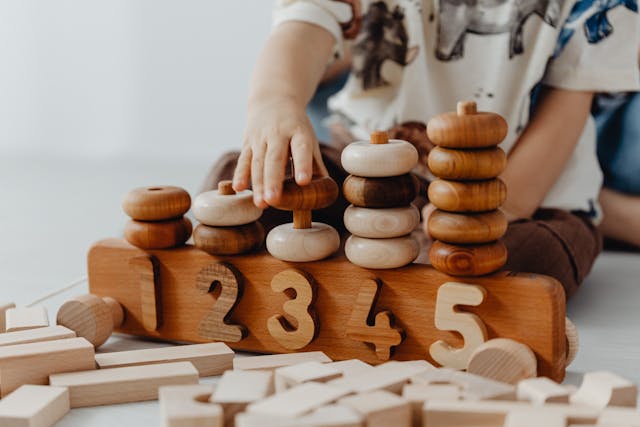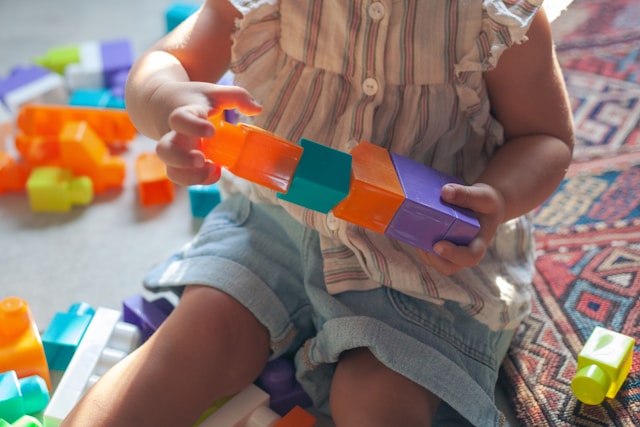Smart Play for a Smarter Tomorrow
A Common Parenting Dilemma: “Am I Giving My Child the Right Toys?”
When Priya became a first-time mom, she stocked her baby’s nursery with colorful rattles, soft teddy bears, and flashy musical toys. But after a few months, she noticed something troubling.
Her baby seemed bored.
The toys just sat there.
And Priya couldn’t help but wonder: “Are these really helping my baby’s growth or just making noise?”
If you’ve ever felt overwhelmed choosing the “right” toys for your little one, you’re not alone. With so many options flooding the market, many parents struggle with a key question:
“How do I know which toys actually support my child’s brain and body development?”
That’s where age-appropriate baby toys designed for cognitive and motor development come in.
Why Toy Selection Matters (More Than You Think)
From birth to age four, your child’s brain grows faster than at any other time in life. This critical window shapes language, memory, coordination, problem-solving, and social-emotional intelligence.
The right toys can:
- Stimulate brain development
- Strengthen motor skills
- Encourage curiosity and creativity
- Lay the foundation for lifelong learning
But when toys are mismatched either too simple or too complex they can cause frustration, disinterest, or even developmental delays.
Let’s break it down stage by stage and discover how to match the best toys to your child’s unique age and abilities.
0–6 Months: Sensory Exploration & Reflex Development

Pain Point: “My baby isn’t playing with toys yet. Do they even need any?”
Solution: Yes they’re learning through their senses. At this age, babies explore the world through touch, sight, and sound. The goal is to support sensory engagement and early reflexes.
Ideal Cognitive & Motor Development Toys:
- High-contrast black-and-white cards for visual stimulation
- Soft rattles and crinkly cloth books for auditory feedback
- Tummy time mirrors to build neck strength and self-recognition
Textured teething rings for sensory soothing
Lovevery Play Kits like The Looker are tailored to support visual tracking and sensory exploration from birth.
6–12 Months: Sitting, Grasping, and Cause-Effect Play

Pain Point: “My baby keeps throwing toys instead of playing. What’s going on?”
Solution: They’re learning cause and effect! Around this age, babies love repetition, grabbing, and experimenting with motion.
Top Toys for Cognitive and Motor Skills:
- Stacking cups and rings for coordination
- Pop-up toys to teach cause and effect
- Soft activity cubes with zippers, Velcro, and textures
- Simple musical instruments (e.g., maracas, xylophones) for auditory stimulation
- Push-and-pull toys for crawling and balance practice
Try sensory toys for babies with different fabrics and sounds to support tactile learning.
Lovevery’s “The Inspector” kit is perfect for exploring object permanence and fine motor control.
12–18 Months: Walking, Problem Solving & Imaginative Play

Pain Point: “My toddler won’t sit still for any toys should I worry?”
Solution: They’re ready for active, open-ended play! This stage brings new mobility and curiosity. Children are beginning to understand how things work and love mimicking daily routines.
Age-Appropriate Baby Toys for 1-Year-Olds:
- Shape sorters and nesting boxes for early problem-solving
- Push carts and walkers to develop leg strength and coordination
- Pretend play sets like toy phones, kitchen sets, or doctor kits
- Wooden block sets to build stacking and spatial awareness
Cognitive development toys like puzzles with large knobs also introduce logical thinking.
Lovevery’s “The Realist” play kit is ideal for this exploratory phase, featuring problem-solving and pretend play tools.
18–24 Months: Language & Fine Motor Explosion

Pain Point: “My toddler gets bored fast. How do I keep them engaged?”
Solution: Offer toys that evolve with their abilities. Around 18 months, children start stringing words, imitating adults, and showing preferences.
Development-Focused Toys for Toddlers:
- Simple toddler puzzles with animal or shape themes
- Peg boards and lacing beads for hand-eye coordination
- Pretend tools or food sets to mimic daily life
- Picture books with textures or flaps to support early reading skills
- Musical instruments like drums or tambourines
Combine sensory toys with storytelling to keep them focused and learning through play.
Lovevery’s “The Companion” kit introduces early art, pretend-play, and sorting activities.
2–3 Years: Imagination, Independence & Skill Building
Pain Point: “My child keeps asking ‘why’ and wants to do everything themselves!”
Solution: Encourage open-ended and creative play. At this stage, toddlers want independence, control, and answers. They love to role-play and “help” with tasks.
Top Age-Appropriate Toys:
- Dress-up clothes and imaginative play sets
- Puzzles with 4–8 pieces
- Matching card games and memory boards
- Building toys like Duplo or magnetic tiles
- Ride-on toys or mini scooters for gross motor play
Toys that involve sorting, matching, or story-building boost both cognitive and emotional development.
Lovevery’s “The Helper” kit promotes routines, emotional awareness, and practical life skills.
3–4 Years: Focused Attention, Problem Solving & Social Play
Pain Point: “My child is always asking for screen time. How do I make real toys more exciting?”
Solution: Offer challenging, rewarding toys with a social angle. Kids at this age enjoy rules, teamwork, and more complex problem-solving.
Advanced Cognitive Development Toys:
- Board games with simple rules (e.g., matching, memory)
- STEM kits or beginner science toys
- Craft kits for painting, gluing, or creating
- Storytelling dolls and puppets
- Age-appropriate puzzles (8–20 pieces)
Toddler puzzles with increasing complexity help develop patience and concentration.
Lovevery’s “The Investigator” kit is filled with science experiments, memory games, and storytelling tools.
Tips for Choosing the Right Toy at Every Stage
1. Match the skill level – A toy should be just challenging enough to spark curiosity, not cause frustration.
2. Look for open-ended play – Toys that can be used in multiple ways grow with your child.
3. Prioritize safety and sustainability – Choose toys made with non-toxic materials and responsibly sourced wood or silicone.
4. Less is more – A few well-chosen age-appropriate baby toys are far more effective than an overflowing toy box.
The Power of Play: More Than Just Fun
Playing isn’t just fun, it’s how babies and toddlers make sense of the world. With the right toys, they aren’t just being entertained. They’re:
- Strengthening neural pathways
- Building emotional intelligence
- Developing coordination, speech, and memory
- Learning how to think, solve, and adapt
So when you invest in cognitive development toys or curated options like Lovevery play kits, you’re setting the stage for a confident, curious learner.
Read more:
When Do Babies Start Sleeping Through the Night?
Finger Sucking in Children: Understanding the Habit and Its Implications
Is Finger-Sucking Safe for Infants? A Comprehensive Guide
Final Thoughts: A Toybox That Teaches and Transforms
Parenting comes with enough worries. Choosing toys shouldn’t be one of them.
By selecting age-appropriate toys for cognitive and motor development, you’re giving your child more than playtime’ you’re giving them a head start in life.
And you’re replacing doubts with something every parent deserves: peace of mind.

